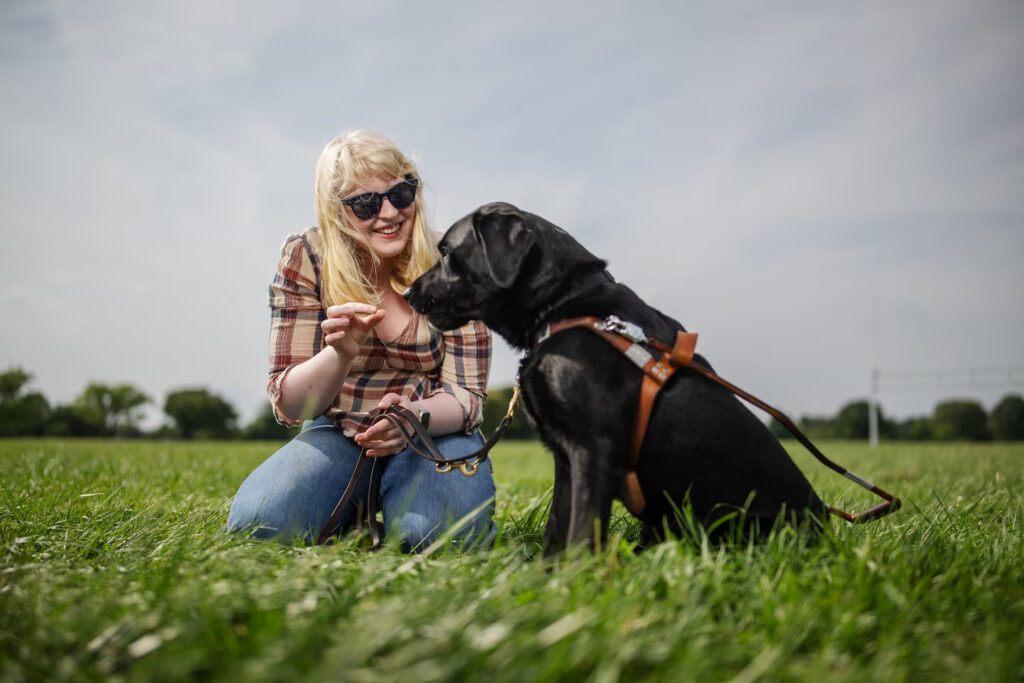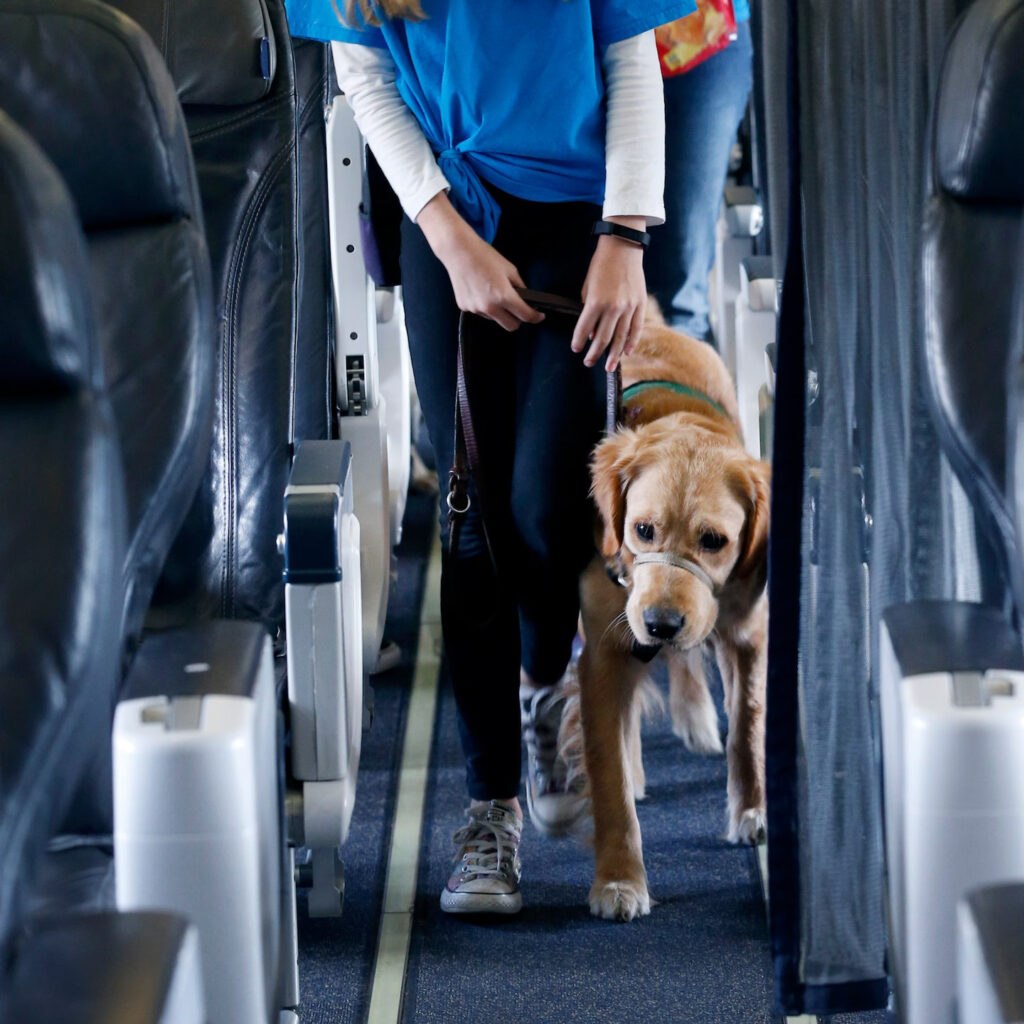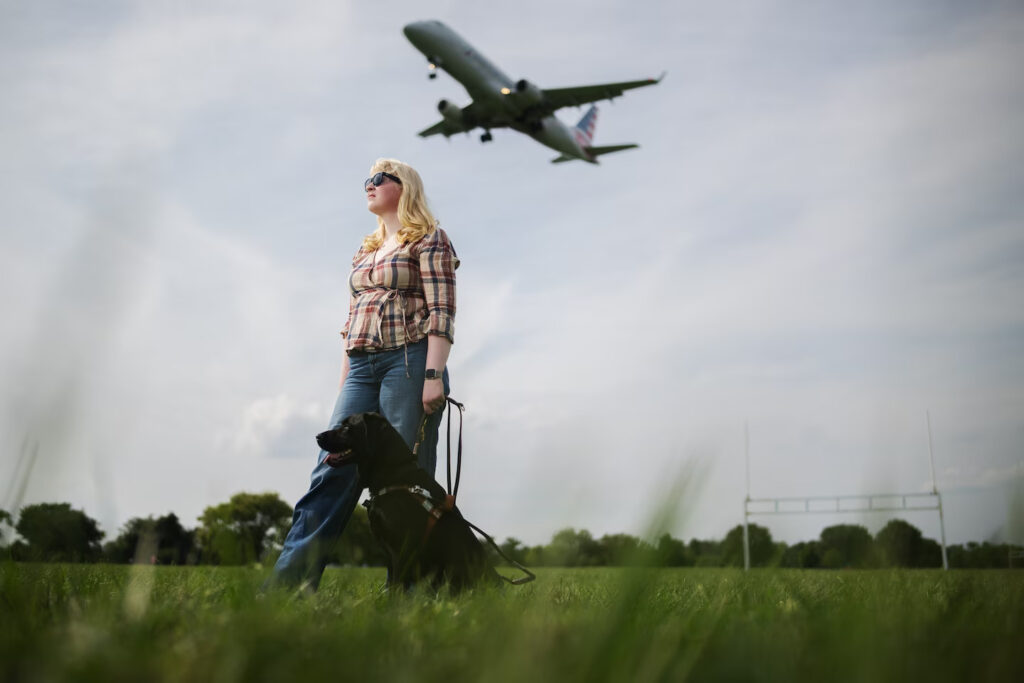In a plot twist orchestrated by the Department of Transportation, navigating the skies has become a labyrinth for our visually impaired fellow travelers. The recent rule adjustments have added an extra layer of complexity, occasionally transforming the once-friendly skies into a puzzling challenge for those with a penchant for navigating without sight.
Meet Elizabeth Schoen and her astute guide dog, Eva—a dynamic duo accustomed to conquering the chaos of airports with finesse. Hailing from Arlington, Va., Elizabeth, who is blind, relies on Eva’s remarkable abilities to navigate bustling environments, from finding elevators to gracefully weaving through crowds en route to the baggage claim.
However, their airborne ambitions hit turbulence when Elizabeth, 21, embarked on a journey to explore graduate schools in Boston last March. To her dismay, airline personnel informed her that Eva, her black Labrador extraordinaire, was not cleared for takeoff.
This incident echoes the experiences of numerous visually impaired individuals who share tales of heightened challenges since the Department of Transportation implemented new regulations in January 2021. Crafted to curb the growing trend of passengers passing off untrained pets as service or emotional support animals, these rules inadvertently created hurdles for genuine service animal teams.
The aviation arena witnessed a menagerie of unconventional companions attempting to board planes, ranging from peacocks and pigs to ducks and even miniature horses. Some of these unconventional passengers left their mark by relieving themselves mid-flight or engaging in less-than-friendly encounters with crew members, passengers, and legitimate service dogs.
In response, the Department of Transportation redefined the rules, specifically excluding emotional support animals from the service animal category and narrowing it down to properly trained dogs. Airlines now have the authority to request passengers to submit forms detailing their service dog’s training at least 48 hours before departure. Despite these changes, airlines are mandated to make reasonable efforts to accommodate passengers with service dogs, even if the requisite forms are submitted belatedly. The skies may be adjusting to these new regulations, but the tales of service animals and their human companions continue to soar, navigating through a regulatory landscape that strives to strike a delicate balance.

Disability advocates are voicing concerns over the inconsistent interpretation of the regulations by airlines, leading to varying rules for document submission and rejections based on simple paperwork errors or incompatible forms from other airlines’ websites.
Passengers, particularly blind travelers, highlight the challenge of filling out the required forms, citing difficulties with compatibility with screen reader technology—a crucial tool for converting text to speech. The complexity of the regulations has created a sense of hesitancy and anxiety about air travel among blind individuals, with some now reluctant to fly. Advocacy groups for the blind are actively calling for a revision or elimination of the cumbersome forms.
Data from the Department of Transportation reveals a significant surge in service-animal-related complaints from people with disabilities since the implementation of the new regulations. In 2018, the agency received 116 complaints, a number that skyrocketed to 451 in 2022. Acknowledging the challenges faced by people with disabilities, the agency stated in an email that it takes these concerns seriously and has initiated a deeper investigation into the issues at hand.
Albert Elia, a board member at the National Association of Guide Dog Users and a staff attorney at the Civil Rights Education and Enforcement Center, a nonprofit organization dedicated to disability justice, aptly sums up the situation, describing it as a “gigantic mess.” The turbulence in the implementation of regulations not only underscores the need for a comprehensive review but also emphasizes the importance of ensuring that air travel remains accessible and stress-free for all passengers, including those with disabilities.

A Denied Entry Experience at the Airport
Elizabeth Schoen found herself entangled in a web of challenges as she endeavored to embark on a journey with her steadfast guide dog, Eva. Despite diligently attempting to submit the necessary form online four days before her scheduled JetBlue flight, her efforts were met with rejection by the airline. JetBlue’s customer service, in response, recommended that she bring the paperwork to the airport on the day of her departure.
Upon reaching the airport, however, Schoen faced disheartening news from airline staff, who claimed her form had not been submitted on time, wielding the authority to deny entry to her loyal companion. Emphasizing the profound connection between herself and Eva, Schoen passionately declared, “If you’re denying my dog, you’re denying me.” The consequence of this denial was a missed flight, prompting her to spend around $400 to secure an alternative with a different airline the following day.
Although Schoen eventually received reimbursement for her original flight, the revelation that her form had been rejected due to an incorrect flight confirmation code underscored a recurring theme of difficulty she encountered when submitting the required documentation, often accompanied by a sense of suspicion from airline staff.
Reflecting on these disheartening experiences, Schoen candidly shared the heightened anxiety she now associates with airport visits. Even when confident in her approval status, there lingers a pervasive feeling of being under constant scrutiny.
JetBlue, when approached about Schoen’s case, did not provide specific responses. However, the airline’s spokesman, Derek Dombrowski, emphasized the imperative of timely form submission to assess a service dog’s eligibility for travel. Dombrowski acknowledged that approximately 80 percent of applications are typically approved but stressed that customers failing to submit in advance might encounter travel restrictions. This incident illuminates the pressing need for enhanced communication and standardized procedures, ensuring a smoother and more empathetic experience for individuals traveling with their invaluable service animals.
Hard-to-reach paperwork

Navigating the intricacies of form submissions proves to be a formidable task for blind users, demanding the latest screen-reader technology that comes with a hefty price tag, exceeding $1,000, as highlighted by Elia, an attorney at the Civil Rights Education and Enforcement Center. The challenges extend beyond the cost, with issues such as improperly labeled text boxes and the inability to interact with certain elements, making the process arduous. Elia, despite his familiarity with the technology, invested over 30 minutes in completing the form, encountering additional roadblocks on specific devices and browsers where form submission was impossible.
The weight of these intricate forms has led travelers like Sherry Gomes, a 65-year-old resident of Patterson, California, to rethink air travel altogether. A former instructor in computer skills for the blind, Gomes, faced with the frustration of completing the form herself, expressed concern about the hurdles faced by individuals with less experience in handling such technology.
In response to the challenges raised, the Department of Transportation assures that they’ve consulted disability rights organizations and collaborated with accessibility testers during the form development process. Actively investigating potential issues, the department is open to feedback and actively seeking ways to enhance the forms for a more accessible and user-friendly experience.
The Ongoing Struggle Against Fake Service Animals

In the face of formidable challenges posed by these forms, they fall short in deterring individuals from dishonestly attempting to pass off untrained pets as legitimate service animals, according to Eric Lipp, the executive director of Open Doors Organization. This organization reviews service-dog forms for major airlines, including JetBlue, Alaska Airlines, Allegiant Air, and Sun Country Airlines.
The forms necessitate owners to affirm that their dogs are adequately trained to assist with their disabilities and behave appropriately in public settings. Owners are also required to provide veterinarian contact information and the date of the last vaccination, but no additional documentation is mandated. Identifying authentic service dogs from fraudulent ones remains a complex task, especially as some service animals are trained by individuals or owners rather than established organizations.
Critics, including Michael Stein, the executive director of the Harvard Law School Project on Disability, argue that these regulations are poorly designed, introducing additional hurdles for people with disabilities. Stein questions the logic and efficacy of the forms, asserting that they fail to equip airline staff to effectively distinguish between fake and genuine service dogs.
While the Americans With Disabilities Act allows businesses to inquire about the necessity of service dogs due to a disability and the tasks these dogs are trained to perform, the potential for faking the need for a service dog remains, particularly for conditions like psychiatric disorders or invisible disabilities. Michael Elia, a board member at the National Association of Guide Dog Users, highlights the difficulty in verifying whether a dog is trained to perceive seizures and raises concerns about privacy violations if individuals are compelled to prove their disabilities.
Despite efforts by some airlines to seek verification from service-dog training programs, a warning from the Civil Rights Education and Enforcement Center has drawn attention to the potential violation of the Health Insurance Portability and Accountability Act (HIPAA). Notwithstanding these challenges, Airlines for America, a trade group representing U.S. airlines, remained silent on inquiries about verification practices. In response, Hannah Walden, a spokeswoman for the association, stated in an email that its members adhere to the rules set by the Department of Transportation.

The Challenge of Service Animal Verification
Crafted with the intention of safeguarding passengers and aircrews, the Department of Transportation introduced rules to ensure safety and well-being during air travel. Interestingly, the agency acknowledges a gap in data, leaving uncertainty about the effectiveness of these rules in reducing incidents involving untrained animals on flights.
JetBlue reports a noteworthy decrease in disruptions caused by untrained dogs, although challenges persist, as outlined by Dombrowski. Curiously, the airline faces incidents with service dogs—such as biting customers or crew members—approximately every three weeks on average.
Donald Overton Jr., the visionary leader of the Blinded Veterans Association, underscores the vital role of screening out fake service animals, not just for the safety of passengers and aircrews but also to protect the authenticity of genuine service animals. Sharing a poignant personal experience, Overton recounts the story of Pierce, his guide dog—a meticulously trained German Shepherd. Pierce’s journey was marred by multiple attacks from untrained pets in planes and airports, ultimately affecting the dog’s ability to function as a service animal.
“In the blink of an eye, somebody who has just casually and carelessly decided that their pet should be out there can take all of that and destroy it,” reflects Overton, highlighting the delicate balance between ensuring safety and preserving the invaluable work of genuine service animals.
Advocating Change
Advocacy groups, including the American Council of the Blind, Guide Dog Users Inc., the National Federation of the Blind, and the National Association of Guide Dog Users, are actively engaging with Department of Transportation staff, urging for changes or the elimination of the existing forms.
John G. Paré Jr., the executive director for advocacy and policy at the National Federation of the Blind, emphasizes the need for equality in the process for guide dogs, stating, “We don’t think airlines, with regard to guide dogs, should require a separate process than what is required for everyone else.”
However, altering these rules may be a time-consuming process, as proposed regulations undergo a public comment period before decisions are made.
In the interim, some organizations are supporting a provision in the Senate Federal Aviation Administration Reauthorization Act. This provision aims to establish a pilot program allowing people to register their service dogs. The program would enable individuals with visual impairments to fly repeatedly with guide dogs, based on a one-time approval process rather than the need to submit a form for every flight.
This provision is part of bipartisan efforts to enhance air travel for disabled passengers as Congress prepares to reauthorize the Federal Aviation Administration’s funding and programs before September 30.
Senator Tammy Duckworth (D-Ill.), a double leg amputee due to combat injuries sustained as a U.S. military pilot, drafted the provision. She highlights that the program would create a more streamlined process for vetting service animals, aiming to address issues where individuals are denied or charged excessive fees during commercial flights.
Jessica Beecham, a 38-year-old from Colorado Springs who is blind, regularly faces questions from airline workers about her guide dog. She has experienced delays at airports for up to four hours due to issues with the form. Beecham describes the situation as a “guessing game” and expresses her desire to “just fly in peace.”
